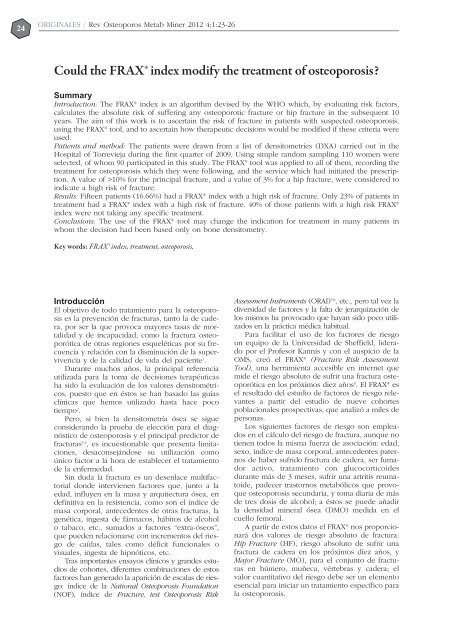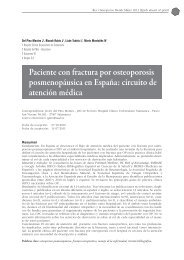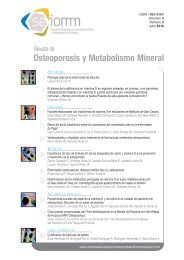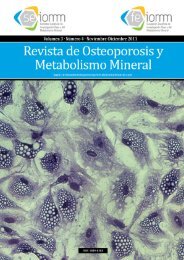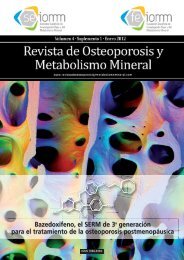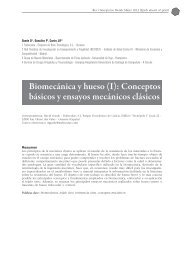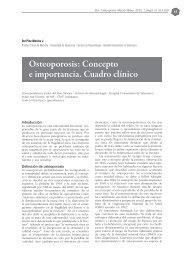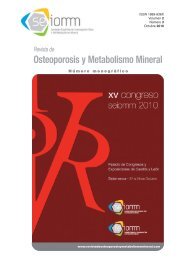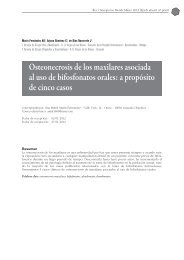Nº 1 Español - Revista de Osteoporosis y Metabolismo Mineral
Nº 1 Español - Revista de Osteoporosis y Metabolismo Mineral
Nº 1 Español - Revista de Osteoporosis y Metabolismo Mineral
Create successful ePaper yourself
Turn your PDF publications into a flip-book with our unique Google optimized e-Paper software.
24<br />
ORIGINALES / Rev Osteoporos Metab Miner 2012 4;1:23-26<br />
Could the FRAX® in<strong>de</strong>x modify the treatment of osteoporosis?<br />
Summary<br />
Introduction: The FRAX ® in<strong>de</strong>x is an algorithm <strong>de</strong>vised by the WHO which, by evaluating risk factors,<br />
calculates the absolute risk of suffering any osteoporotic fracture or hip fracture in the subsequent 10<br />
years. The aim of this work is to ascertain the risk of fracture in patients with suspected osteoporosis,<br />
using the FRAX ® tool, and to ascertain how therapeutic <strong>de</strong>cisions would be modified if these criteria were<br />
used.<br />
Patients and method: The patients were drawn from a list of <strong>de</strong>nsitometries (DXA) carried out in the<br />
Hospital of Torrevieja during the first quarter of 2009. Using simple random sampling 110 women were<br />
selected, of whom 90 participated in this study. The FRAX ® tool was applied to all of them, recording the<br />
treatment for osteoporosis which they were following, and the service which had initiated the prescription.<br />
A value of >10% for the principal fracture, and a value of 3% for a hip fracture, were consi<strong>de</strong>red to<br />
indicate a high risk of fracture.<br />
Results: Fifteen patients (16.66%) had a FRAX ® in<strong>de</strong>x with a high risk of fracture. Only 23% of patients in<br />
treatment had a FRAX ® in<strong>de</strong>x with a high risk of fracture. 40% of those patients with a high risk FRAX ®<br />
in<strong>de</strong>x were not taking any specific treatment.<br />
Conclusions: The use of the FRAX ® tool may change the indication for treatment in many patients in<br />
whom the <strong>de</strong>cision had been based only on bone <strong>de</strong>nsitometry.<br />
Key words: FRAX® in<strong>de</strong>x, treatment, osteoporosis.<br />
Introducción<br />
El objetivo <strong>de</strong> todo tratamiento para la osteoporosis<br />
es la prevención <strong>de</strong> fracturas, tanto la <strong>de</strong> ca<strong>de</strong>ra,<br />
por ser la que provoca mayores tasas <strong>de</strong> mortalidad<br />
y <strong>de</strong> incapacidad, como la fractura osteoporótica<br />
<strong>de</strong> otras regiones esqueléticas por su frecuencia<br />
y relación con la disminución <strong>de</strong> la supervivencia<br />
y <strong>de</strong> la calidad <strong>de</strong> vida <strong>de</strong>l paciente 1 .<br />
Durante muchos años, la principal referencia<br />
utilizada para la toma <strong>de</strong> <strong>de</strong>cisiones terapéuticas<br />
ha sido la evaluación <strong>de</strong> los valores <strong>de</strong>nsitométricos,<br />
puesto que en éstos se han basado las guías<br />
clínicas que hemos utilizado hasta hace poco<br />
tiempo 2 .<br />
Pero, si bien la <strong>de</strong>nsitometría ósea se sigue<br />
consi<strong>de</strong>rando la prueba <strong>de</strong> elección para el diagnóstico<br />
<strong>de</strong> osteoporosis y el principal predictor <strong>de</strong><br />
fracturas 3-6 , es incuestionable que presenta limitaciones,<br />
<strong>de</strong>saconsejándose su utilización como<br />
único factor a la hora <strong>de</strong> establecer el tratamiento<br />
<strong>de</strong> la enfermedad.<br />
Sin duda la fractura es un <strong>de</strong>senlace multifactorial<br />
don<strong>de</strong> intervienen factores que, junto a la<br />
edad, influyen en la masa y arquitectura ósea, en<br />
<strong>de</strong>finitiva en la resistencia, como son el índice <strong>de</strong><br />
masa corporal, antece<strong>de</strong>ntes <strong>de</strong> otras fracturas, la<br />
genética, ingesta <strong>de</strong> fármacos, hábitos <strong>de</strong> alcohol<br />
o tabaco, etc., sumados a factores “extra-óseos”,<br />
que pue<strong>de</strong>n relacionarse con incrementos <strong>de</strong>l riesgo<br />
<strong>de</strong> caídas, tales como déficit funcionales o<br />
visuales, ingesta <strong>de</strong> hipnóticos, etc.<br />
Tras importantes ensayos clínicos y gran<strong>de</strong>s estudios<br />
<strong>de</strong> cohortes, diferentes combinaciones <strong>de</strong> estos<br />
factores han generado la aparición <strong>de</strong> escalas <strong>de</strong> riesgo:<br />
índice <strong>de</strong> la National <strong>Osteoporosis</strong> Foundation<br />
(NOF), índice <strong>de</strong> Fracture, test <strong>Osteoporosis</strong> Risk<br />
Assessment Instruments (ORAI) 7-8 , etc., pero tal vez la<br />
diversidad <strong>de</strong> factores y la falta <strong>de</strong> jerarquización <strong>de</strong><br />
los mismos ha provocado que hayan sido poco utilizados<br />
en la práctica médica habitual.<br />
Para facilitar el uso <strong>de</strong> los factores <strong>de</strong> riesgo<br />
un equipo <strong>de</strong> la Universidad <strong>de</strong> Sheffield, li<strong>de</strong>rado<br />
por el Profesor Kannis y con el auspicio <strong>de</strong> la<br />
OMS, creó el FRAX ® (Fracture Risk Assessment<br />
Tool), una herramienta accesible en internet que<br />
mi<strong>de</strong> el riesgo absoluto <strong>de</strong> sufrir una fractura osteoporótica<br />
en los próximos diez años 9 . El FRAX ® es<br />
el resultado <strong>de</strong>l estudio <strong>de</strong> factores <strong>de</strong> riesgo relevantes<br />
a partir <strong>de</strong>l estudio <strong>de</strong> nueve cohortes<br />
poblacionales prospectivas, que analizó a miles <strong>de</strong><br />
personas.<br />
Los siguientes factores <strong>de</strong> riesgo son empleados<br />
en el cálculo <strong>de</strong>l riesgo <strong>de</strong> fractura, aunque no<br />
tienen todos la misma fuerza <strong>de</strong> asociación: edad,<br />
sexo, índice <strong>de</strong> masa corporal, antece<strong>de</strong>ntes paternos<br />
<strong>de</strong> haber sufrido fractura <strong>de</strong> ca<strong>de</strong>ra, ser fumador<br />
activo, tratamiento con glucocorticoi<strong>de</strong>s<br />
durante más <strong>de</strong> 3 meses, sufrir una artritis reumatoi<strong>de</strong>,<br />
pa<strong>de</strong>cer trastornos metabólicos que provoque<br />
osteoporosis secundaria, y toma diaria <strong>de</strong> más<br />
<strong>de</strong> tres dosis <strong>de</strong> alcohol; a éstos se pue<strong>de</strong> añadir<br />
la <strong>de</strong>nsidad mineral ósea (DMO) medida en el<br />
cuello femoral.<br />
A partir <strong>de</strong> estos datos el FRAX ® nos proporcionará<br />
dos valores <strong>de</strong> riesgo absoluto <strong>de</strong> fractura:<br />
Hip Fracture (HF), riesgo absoluto <strong>de</strong> sufrir una<br />
fractura <strong>de</strong> ca<strong>de</strong>ra en los próximos diez años, y<br />
Major Fracture (MO), para el conjunto <strong>de</strong> fracturas<br />
en húmero, muñeca, vértebras y ca<strong>de</strong>ra; el<br />
valor cuantitativo <strong>de</strong>l riesgo <strong>de</strong>be ser un elemento<br />
esencial para iniciar un tratamiento específico para<br />
la osteoporosis.


